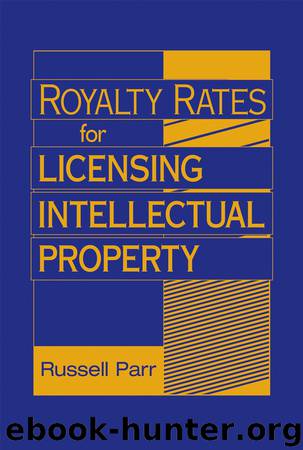Royalty Rates for Licensing Intellectual Property by Russell Parr

Author:Russell Parr
Language: eng
Format: epub
Publisher: John Wiley & Sons, Ltd.
Published: 2012-04-05T04:00:00+00:00
PHARMACEUTICALS AND BIOTECHNOLOGY
Massive innovation and capital investment characterize this industry. Blockbuster therapies, with annual sales over $1 billion, can generate incremental profits nearing ninety percent of sales. The patented technology of pharmaceuticals and biotechnology companies is very unique. It requires a huge investment in research and development, for products that won’t generate any revenue for many years, with a high probability of failure before commercialization can begin. However, when successful, these products deliver extraordinarily high profit margins, and billions of dollars in annual revenue. Market risk is not as significant a problem in this industry, as in others. As an example, if a cure for cancer is developed, the market will embrace the product.
During the past ten years, royalty rates have been pressured upward by several conditions within the pharmaceutical industry:
New drug discovery has become increasingly difficult.
It takes twelve to fourteen years, and several hundred million dollars, to put a new drug on the market.
Pharmaceutical companies are under constant pressure to continually obtain, or discover, promising new compounds.
Internal research and development pipelines are not sufficiently filled with new discoveries and products.
Pharmaceutical companies need to supplement their research and development deficiencies with licensing activities.
Pharmaceutical companies are in heated competition to acquire new molecules and technology from any source.20
In 2004, the global drug therapy market was $550 billion.21 The United States is the world’s dominant market, representing forty-five percent of global sales; Western Europe comprises twenty-six percent, and Japan represents eleven, while the rest of the world represents the remaining eighteen.
Major biotech firms include Amgen, Biogen Idec, Chiron, Genentech, and MedImmune. The largest traditional pharmaceutical companies include Pfizer, GlaxoSmithKline, Johnson and Johnson, AstraZeneca, Novartis, Amgen, and Wyeth. Sales of biotechnology products are growing at double-digit rates, while traditional pharmaceutical companies have recently experienced only single-digit growth.
Challenges to industry participants include generic (off-patent) products, and over-the-counter (OTC) products. As patent protection expires, competitive companies produce equivalents to branded predecessors, but at significantly discounted prices. This increases the pressure for the development of new, patented products to replace the high profit, off-patent products lost to generic producers. As a result, pharmaceutical and biotechnology companies spend more on research and development, as a percentage of sales, than any other industry.
The pharmaceutical and biotechnology industry has yielded a substantial number of royalty guidelines, as reported in Exhibit 6.1 below, based on data gathered by David Weiler of RoyaltySource, who compiled the data shown from a survey of four hundred fifty-eight Pharmaceutical and Biotechnology license agreements.22 Remember, the average royalty rate across all industries was previously reported to be five percent of sales. For pharmaceuticals and biotechnology, the average is significantly higher, at seven percent.
EXHIBIT 6.1 Royalty Rate Distribution for Pharmaceuticals
Download
This site does not store any files on its server. We only index and link to content provided by other sites. Please contact the content providers to delete copyright contents if any and email us, we'll remove relevant links or contents immediately.
You Don't Own Me by Orly Lobel(1383)
Intellectual Property Strategy by John Palfrey(1340)
Hello, My Name is Awesome by Alexandra Watkins(1307)
Without Copyrights by Spoo Robert(1206)
Profit From Your Idea: How to Make Smart Licensing Deals by Attorney Richard Stim(1184)
Democracy of Sound by Alex Sayf Cummings(1165)
A Triumph of Genius: Edwin Land, Polaroid, and the Kodak Patent War by Ronald K. Fierstein(1141)
The Trademark Guide by Lee Wilson(1139)
The Copywriter's Handbook by Robert W. Bly(1103)
World War 3.0 by Ken Auletta(1101)
Data Protection: A Practical Guide to UK and EU Law by Carey Peter(1087)
Kafka's Last Trial by Benjamin Balint(1075)
BVR's Guide to Intellectual Property Valuation by Michael Pellegrino(1030)
Mass Media Law by Pember Don & Pember Don(1022)
Patent It Yourself: Your Step-by-Step Guide to Filing at the U.S. Patent Office by Pressman David Attorney(1013)
Hello, My Name Is Awesome: How to Create Brand Names That Stick (BK Business) by Alexandra Watkins(1009)
What They'll Never Tell You About the Music Business by Peter M. Thall(1009)
The Tech Contracts Handbook: Software Licenses and Technology Services Agreements for Lawyers and Businesspeople by David Tollen(1002)
The New Censorship: Inside the Global Battle for Media Freedom by Joel Simon(968)
